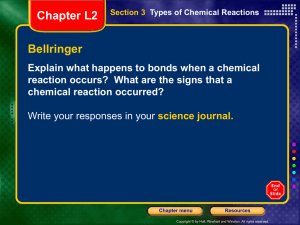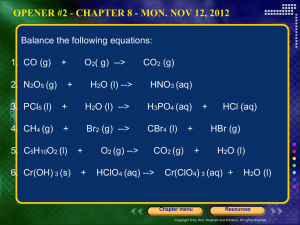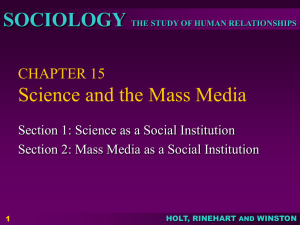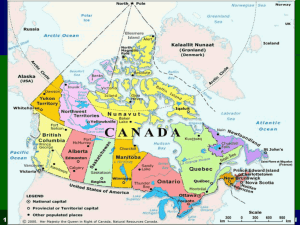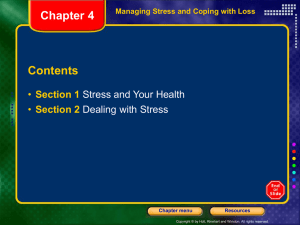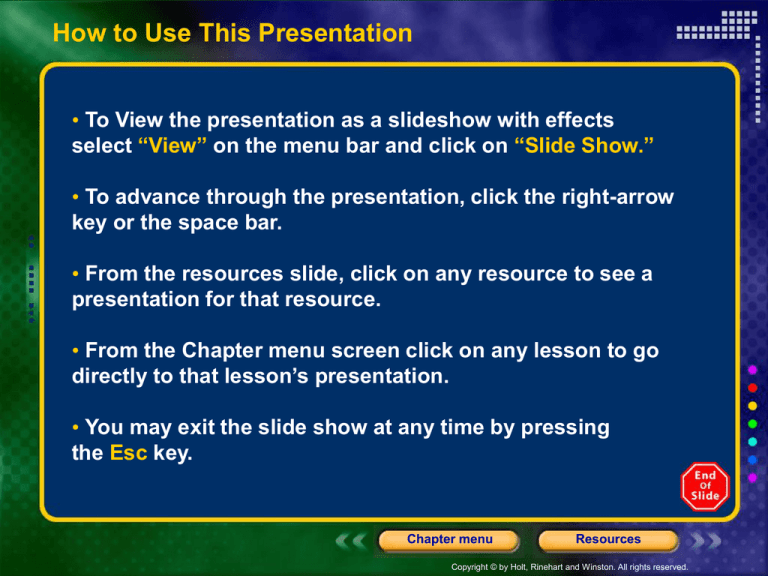
How to Use This Presentation
• To View the presentation as a slideshow with effects
select “View” on the menu bar and click on “Slide Show.”
• To advance through the presentation, click the right-arrow
key or the space bar.
• From the resources slide, click on any resource to see a
presentation for that resource.
• From the Chapter menu screen click on any lesson to go
directly to that lesson’s presentation.
• You may exit the slide show at any time by pressing
the Esc key.
Chapter menu
Resources
Copyright © by Holt, Rinehart and Winston. All rights reserved.
Resources
Chapter Presentation
Bellringer
Transparencies
Sample Problems
Visual Concepts
Standardized Test Prep
Chapter menu
Resources
Copyright © by Holt, Rinehart and Winston. All rights reserved.
Chapter 6
Covalent Compounds
Table of Contents
Section 1 Covalent Bonds
Section 2 Drawing and Naming Molecules
Section 3 Molecular Shapes
Chapter menu
Resources
Copyright © by Holt, Rinehart and Winston. All rights reserved.
Chapter 6
Section 1 Covalent Bonds
Bellringer
• Make a list of the elements that form ionic bonds.
Note that most ionic bonds contain a metal and a
nonmetal.
Chapter menu
Resources
Copyright © by Holt, Rinehart and Winston. All rights reserved.
Chapter 6
Section 1 Covalent Bonds
Objectives
• Explain the role and location of electrons in a
covalent bond.
• Describe the change in energy and stability that
takes place as a covalent bond forms.
• Distinguish between nonpolar and polar covalent
bonds based on electronegativity differences.
Chapter menu
Resources
Copyright © by Holt, Rinehart and Winston. All rights reserved.
Chapter 6
Section 1 Covalent Bonds
Objectives, continued
• Compare the physical properties of substances that
have different bond types, and relate bond types to
electronegativity differences.
• Ignore pgs.192,193
Chapter menu
Resources
Copyright © by Holt, Rinehart and Winston. All rights reserved.
Chapter 6
Section 1 Covalent Bonds
Sharing Electrons
• When an ionic bond forms, electrons are rearranged
and are transferred from one atom to another to form
charged ions.
• In another kind of change involving electrons, the
neutral atoms share electrons.
Chapter menu
Resources
Copyright © by Holt, Rinehart and Winston. All rights reserved.
Chapter 6
Section 1 Covalent Bonds
Sharing Electrons, continued
Forming Molecular Orbitals
• A covalent bond is a bond formed when atoms share
one or more pairs of electrons.
• The shared electrons move within a space called a
molecular orbital.
• A molecular orbital is the region of high probability
that is occupied by an individual electron as it travels
with a wavelike motion in the three-dimensional space
around one of two or more associated nuclei.
Chapter menu
Resources
Copyright © by Holt, Rinehart and Winston. All rights reserved.
Chapter 6
Formation of a Covalent Bond
Chapter menu
Resources
Copyright © by Holt, Rinehart and Winston. All rights reserved.
Chapter 6
Visual Concepts
Chemical Bond
Chapter menu
Resources
Copyright © by Holt, Rinehart and Winston. All rights reserved.
Chapter 6
Section 1 Covalent Bonds
Energy and Stability
Energy Is Released When Atoms Form a Covalent Bond
Chapter menu
Resources
Copyright © by Holt, Rinehart and Winston. All rights reserved.
Chapter 6
Section 1 Covalent Bonds
Energy and Stability, continued
Potential Energy Determines Bond Length
• When two bonded hydrogen atoms are at their lowest
potential energy, the distance between them is 75 pm.
• The bond length is the distance between two bonded
atoms at their minimum potential energy.
• However, the two nuclei in a covalent bond vibrate back
and forth. The bond length is thus the average distance
between the two nuclei.
Chapter menu
Resources
Copyright © by Holt, Rinehart and Winston. All rights reserved.
Chapter 6
Visual Concepts
Bond Length
Chapter menu
Resources
Copyright © by Holt, Rinehart and Winston. All rights reserved.
Chapter 6
Section 1 Covalent Bonds
Energy and Stability, continued
Bonded Atoms Vibrate, and Bonds Vary in Strength
• The bond length is the average distance between two
nuclei in a covalent bond.
• At a bond length of 75 pm, the potential energy of H2 is
–436 kJ/mol.
• Thus 436 kJ of energy must be supplied to break the
bonds in 1 mol of H2 molecules.
• The energy required to break a bond between two
atoms is the bond energy.
• Bonds that have the higher bond energies
(stronger bonds) have the shorter bond lengths.
Chapter menu
Resources
Copyright © by Holt, Rinehart and Winston. All rights reserved.
Chapter 6
Visual Concepts
Bond Energy
Chapter menu
Resources
Copyright © by Holt, Rinehart and Winston. All rights reserved.
Chapter 6
Section 1 Covalent Bonds
Electronegativity and Covalent Bonding
• In covalent bonds between two different atoms, the
atoms often have different attractions for shared
electrons.
• Electronegativity values are a useful tool to predict
what kind of bond will form.
Chapter menu
Resources
Copyright © by Holt, Rinehart and Winston. All rights reserved.
Chapter 6
Visual Concepts
Electronegativity
Chapter menu
Resources
Copyright © by Holt, Rinehart and Winston. All rights reserved.
Chapter 6
Section 1 Covalent Bonds
Electronegativity and Covalent Bonding,
continued
Atoms Share Electrons Equally or Unequally
• When the electronegativity values of two bonding
atoms are similar, bonding electrons are shared
equally.
• A covalent bond in which the bonding electrons in the
molecular orbital are shared equally is a nonpolar
covalent bond.
Chapter menu
Resources
Copyright © by Holt, Rinehart and Winston. All rights reserved.
Chapter 6
Section 1 Covalent Bonds
Electronegativity and Covalent Bonding,
continued
Atoms Share Electrons Equally or Unequally,
continued
• When the electronegativity values of two bonding
atoms are different, bonding electrons are shared
unequally.
• A covalent bond in which the bonding electrons in the
molecular orbital are shared unequally is a polar
covalent bond.
Chapter menu
Resources
Copyright © by Holt, Rinehart and Winston. All rights reserved.
Chapter 6
Predicting Bond Character from
Electronegativity Differences
Chapter menu
Resources
Copyright © by Holt, Rinehart and Winston. All rights reserved.
Chapter 6
Section 1 Covalent Bonds
Electronegativity and Covalent Bonding,
continued
Polar Molecules Have Positive and Negative Ends
• In a polar covalent bond, the ends of the bond have
opposite partial charges.
• A molecule in which one end has a partial positive
charge and the other end has a partial negative charge
is called a dipole.
• In a polar covalent bond, the shared pair of electrons is
not transferred completely. Instead, it is more likely to be
found near the more electronegative atom.
Chapter menu
Resources
Copyright © by Holt, Rinehart and Winston. All rights reserved.
Chapter 6
Section 1 Covalent Bonds
Electronegativity and Covalent Bonding,
continued
Polar Molecules Have Positive and Negative Ends,
continued
• The symbol is used to mean partial.
• + is used to show a partial positive charge
• – is used to show a partial negative charge charge
• example: H+F–
• Because the F atom has a partial negative charge, the
electron pair is more likely to be found nearer to the
fluorine atom
Chapter menu
Resources
Copyright © by Holt, Rinehart and Winston. All rights reserved.
Chapter 6
Visual Concepts
Comparing Polar and Nonpolar Covalent
Bonds
Chapter menu
Resources
Copyright © by Holt, Rinehart and Winston. All rights reserved.
Chapter 6
Section 1 Covalent Bonds
Polarity Is Related to Bond Strength
• In general, the greater the electronegativity difference,
the greater the polarity and the stronger the bond.
Chapter menu
Resources
Copyright © by Holt, Rinehart and Winston. All rights reserved.
Chapter 6
Section 1 Covalent Bonds
Electronegativity and Bond Types
• Differences in electronegativity values provide one
model that can tell you which type of bond two atoms
will form.
• Another general rule states:
• A covalent bond forms between two nonmetals.
• An ionic bond forms between a nonmetal and a metal.
Chapter menu
Resources
Copyright © by Holt, Rinehart and Winston. All rights reserved.
Chapter 6
Section 1 Covalent Bonds
Properties of Substances Depend on Bond
Type
• The type of bond that forms (metallic, ionic, or
covalent) determines the properties of the substance.
• The difference in the strength of attraction between
the basic units of ionic and covalent substances
causes these types of substances to have different
properties.
Chapter menu
Resources
Copyright © by Holt, Rinehart and Winston. All rights reserved.
Chapter 6
Properties of Substances with Metallic, Ionic,
and Covalent Bonds
Chapter menu
Resources
Copyright © by Holt, Rinehart and Winston. All rights reserved.
Chapter 6
Section 6.1 review, pg 198
1. Describe the attractive forces and repulsive
forces that exist between two atoms as the
atoms move closer together.
The positive nucleus of each atom attracts the electrons of the
other atom. At the same time, the nuclei repel each other, as
do the electron clouds.
3. In what two ways can two atoms share electrons
when forming a covalent bond?
The two atoms may share electrons equally, forming a nonpolar
covalent bond, or unequally, forming a polar covalent bond.
Chapter menu
Resources
Copyright © by Holt, Rinehart and Winston. All rights reserved.
Chapter 6
5. How are the partial charges shown in a polar
covalent molecule?
The symbol
is written as a superscript on the element with the
partial positive charge. The symbol
is written as a
superscript on the element with the partial negative charge.
6. What information can be obtained by knowing the
electronegativity differences between two elements?
Knowing the electronegativity difference suggests what type of
bond will form between the atoms of the two elements.
Chapter menu
Resources
Copyright © by Holt, Rinehart and Winston. All rights reserved.
Chapter 6
7. Why do molecular compounds have low melting
points and low boiling points relative to ionic
substances?
The attractive forces between individual molecules are weak,
accounting for the low melting point of molecular compounds.
Chapter menu
Resources
Copyright © by Holt, Rinehart and Winston. All rights reserved.
Chapter 6
Section 2 Drawing and Naming
Molecules
Bellringer
• Classify the following compounds according to the
type of bonds they contain:
• NO
• CO
• HF
• NaCl
• HBr
• NaI
Chapter menu
Resources
Copyright © by Holt, Rinehart and Winston. All rights reserved.
Chapter 6
Section 2 Drawing and Naming
Molecules
Objectives
• Draw Lewis structures to show the arrangement of
valence electrons among atoms in molecules and
polyatomic ions.
• Explain the differences between single, double, and
triple covalent bonds.
• Draw resonance structures for simple molecules and
polyatomic ions, and recognize when they are
required.
Chapter menu
Resources
Copyright © by Holt, Rinehart and Winston. All rights reserved.
Chapter 6
Section 2 Drawing and Naming
Molecules
Objectives, continued
• Name binary inorganic covalent compounds by using
prefixes, roots, and suffixes.
Chapter menu
Resources
Copyright © by Holt, Rinehart and Winston. All rights reserved.
Chapter 6
Section 2 Drawing and Naming
Molecules
Lewis Electron-Dot Structures
• Valence electrons are the electrons in the outermost
energy level of an atom.
• A Lewis structure is a structural formula in which
valence electrons are represented by dots.
• In Lewis structures, dot pairs or dashes between two
atomic symbols represent pairs in covalent bonds.
Chapter menu
Resources
Copyright © by Holt, Rinehart and Winston. All rights reserved.
Chapter 6
Visual Concepts
Valence Electrons
Chapter menu
Resources
Copyright © by Holt, Rinehart and Winston. All rights reserved.
Chapter 6
Section 2 Drawing and Naming
Molecules
Lewis Electron-Dot Structures, continued
Lewis Structures Show Valence Electrons
• As you go from element to element across a period,
you add a dot to each side of the element’s symbol.
Chapter menu
Resources
Copyright © by Holt, Rinehart and Winston. All rights reserved.
Chapter 6
Section 2 Drawing and Naming
Molecules
Lewis Electron-Dot Structures, continued
Lewis Structures Show Valence Electrons, continued
• You do not begin to pair dots until all four sides of the
element’s symbol have a dot.
Chapter menu
Resources
Copyright © by Holt, Rinehart and Winston. All rights reserved.
Chapter 6
Section 2 Drawing and Naming
Molecules
Lewis Electron-Dot Structures, continued
Lewis Structures Show Valence Electrons, continued
• An element with an octet of valence electrons has a
stable configuration.
• The tendency of bonded atoms to have octets of
valence electrons is called the octet rule.
Chapter menu
Resources
Copyright © by Holt, Rinehart and Winston. All rights reserved.
Chapter 6
Visual Concepts
The Octet Rule
Chapter menu
Resources
Copyright © by Holt, Rinehart and Winston. All rights reserved.
Chapter 6
Section 2 Drawing and Naming
Molecules
Lewis Electron-Dot Structures, continued
Lewis Structures Show Valence Electrons, continued
• When two chlorine atoms form a covalent bond, each
atom contributes one electron to a shared pair.
• An unshared pair, or a lone pair, is a nonbonding
pair of electrons in the valence shell of an atom.
Chapter menu
Resources
Copyright © by Holt, Rinehart and Winston. All rights reserved.
Chapter 6
Section 2 Drawing and Naming
Molecules
Lewis Electron-Dot Structures, continued
Lewis Structures Show Valence Electrons, continued
• A single bond is a covalent bond in which two atoms
share one pair of electrons
• The electrons can pair in any order. However, any
unpaired electrons are usually filled in to show how
they will form a covalent bond.
Chapter menu
Resources
Copyright © by Holt, Rinehart and Winston. All rights reserved.
Chapter 6
Section 2 Drawing and Naming
Molecules
Drawing Lewis Structures with Single Bonds
Sample Problem A
Draw a Lewis structure for CH3I.
Chapter menu
Resources
Copyright © by Holt, Rinehart and Winston. All rights reserved.
Chapter 6
Section 2 Drawing and Naming
Molecules
Drawing Lewis Structures with Single Bonds
Sample Problem A Solution
Draw each atom’s Lewis structure, and count the total
number of valence electrons.
number of dots: 14
Arrange the Lewis structure so that carbon is the central
atom.
Chapter menu
Resources
Copyright © by Holt, Rinehart and Winston. All rights reserved.
Chapter 6
Section 2 Drawing and Naming
Molecules
Drawing Lewis Structures with Single Bonds
Sample Problem A Solution, continued
Distribute one bonding pair of electrons between each of
the bonded atoms. Then, distribute the remaining electrons,
in pairs, around the remaining atoms to form an octet for
each atom.
Change each pair of dots that represents a shared pair of
electrons to a long dash.
Chapter menu
Resources
Copyright © by Holt, Rinehart and Winston. All rights reserved.
Chapter 6.2
Sample Problem A,practice pg.202
1)Draw the Lewis structures for H2S, CH2Cl2, NH3,
and C2H6.
Chapter menu
Resources
Copyright © by Holt, Rinehart and Winston. All rights reserved.
Chapter 6.2
Sample Problem A,practice pg.202
2)Draw the Lewis structures for methanol, CH3OH.
Chapter menu
Resources
Copyright © by Holt, Rinehart and Winston. All rights reserved.
Chapter 6
Section 2 Drawing and Naming
Molecules
Drawing Lewis Structures for Polyatomic Ions
Sample Problem B
24
Draw a Lewis structure for the sulfate ion, SO
Chapter menu
.
Resources
Copyright © by Holt, Rinehart and Winston. All rights reserved.
Chapter 6
Section 2 Drawing and Naming
Molecules
Drawing Lewis Structures for Polyatomic Ions
Sample Problem B Solution
Count electrons for all atoms. Add two additional electrons
to account for the 2− charge on the ion.
number of dots: 30 + 2 = 32
Distribute the 32 dots so that there are 8 dots around each
atom.
Chapter menu
Resources
Copyright © by Holt, Rinehart and Winston. All rights reserved.
Chapter 6
Section 2 Drawing and Naming
Molecules
Drawing Lewis Structures for Polyatomic Ions
Sample Problem B Solution, continued
Change each bonding pair to a long dash. Place
brackets around the ion and a 2 charge outside the
bracket to show that the charge is spread out over the
entire ion.
Chapter menu
Resources
Copyright © by Holt, Rinehart and Winston. All rights reserved.
Chapter 6.2
Sample Problem B, practice pg.203
1)Draw a Lewis structure for ClO3-
2) Draw the Lewis structure for the hydronium ion,
H3O +
Chapter menu
Resources
Copyright © by Holt, Rinehart and Winston. All rights reserved.
Chapter 6
Section 2 Drawing and Naming
Molecules
Multiple Bonds
• For O2 to make an octet, each atom needs two more
electrons. The two atoms share four electrons.
• A double bond is a covalent bond in which two
atoms share two pairs of electrons.
Chapter menu
Resources
Copyright © by Holt, Rinehart and Winston. All rights reserved.
Chapter 6
Section 2 Drawing and Naming
Molecules
Multiple Bonds, continued
• For N2 to make an octet, each atom needs three more
electrons. The two atoms share six electrons.
• A triple bond is a covalent bond in which two atoms
share three pairs of electrons.
Chapter menu
Resources
Copyright © by Holt, Rinehart and Winston. All rights reserved.
Chapter 6
Visual Concepts
Comparing Single, Double, and Triple Bonds
Chapter menu
Resources
Copyright © by Holt, Rinehart and Winston. All rights reserved.
Chapter 6
Section 2 Drawing and Naming
Molecules
Drawing Lewis Structures with Multiple Bonds
Sample Problem C
Draw a Lewis structure for formaldehyde, CH2O.
Chapter menu
Resources
Copyright © by Holt, Rinehart and Winston. All rights reserved.
Chapter 6
Section 2 Drawing and Naming
Molecules
Drawing Lewis Structures with Multiple Bonds
Sample Problem C Solution
Draw each atom’s Lewis structure, and count the total dots.
number of dots: 12
Arrange the atoms so that carbon is the central atom.
H
O
C H
Chapter menu
Resources
Copyright © by Holt, Rinehart and Winston. All rights reserved.
Chapter 6
Section 2 Drawing and Naming
Molecules
Drawing Lewis Structures with Multiple Bonds
Sample Problem C Solution, continued
Distribute one pair of dots between each of the atoms
and the rest, in pairs, around the atoms. C does not
have an octet. To get an octet, move an unshared pair
from the O to between the O and the C.
Change each bonding pair to a long dash. Two pairs
of dots represent a double bond.
Chapter menu
Resources
Copyright © by Holt, Rinehart and Winston. All rights reserved.
Chapter 6.2
Sample Problem C, practice pg. 205
1) Draw the Lewis structures for carbon dioxide, CO2,
and carbon monoxide, CO.
2) Draw the Lewis structures for ethyne, C2H2, and
Hydrogen cyanide, HCN.
Chapter menu
Resources
Copyright © by Holt, Rinehart and Winston. All rights reserved.
Chapter 6
Section 2 Drawing and Naming
Molecules
Resonance Structures
• Some molecules, such as ozone, O3, cannot be
represented by a single Lewis structure.
• When a molecule has two or more possible Lewis
structures, the two structures are called resonance
structures.
Chapter menu
Resources
Copyright © by Holt, Rinehart and Winston. All rights reserved.
Chapter 6
Visual Concepts
Atomic Resonance
Chapter menu
Resources
Copyright © by Holt, Rinehart and Winston. All rights reserved.
Chapter 6
Section 2 Drawing and Naming
Molecules
Multiple Bonds, continued
Naming Covalent Compounds
• The first element named is usually the first one written
in the formula. It is usually the less-electronegative
element.
• The second element named has the ending -ide.
• Unlike the names for ionic compounds, the names for
covalent compounds must often distinguish between
two different molecules made of the same elements.
Chapter menu
Resources
Copyright © by Holt, Rinehart and Winston. All rights reserved.
Chapter 6
Section 2 Drawing and Naming
Molecules
Naming Covalent Compounds, continued
• This system of prefixes is used to show the number of
atoms of each element in the molecule.
Chapter menu
Resources
Copyright © by Holt, Rinehart and Winston. All rights reserved.
Chapter 6
Section 2 Drawing and Naming
Molecules
Naming Covalent Compounds, continued
• Prefixes can be used to show the numbers of each
type of atom in diphosphorus pentasulfide.
Chapter menu
Resources
Copyright © by Holt, Rinehart and Winston. All rights reserved.
Chapter 6
Visual Concepts
Naming Compounds Using Numerical Prefixes
Chapter menu
Resources
Copyright © by Holt, Rinehart and Winston. All rights reserved.
Homework
Section 6.2 Review, pg. 207
questions 1 to 10
Chapter menu
Resources
Copyright © by Holt, Rinehart and Winston. All rights reserved.
Section 6.2 Review, pg. 207
1. Which electrons do a Lewis structure show?
2. In a polyatomic ion, where is the charge located?
3. How many electrons are shared by two atoms that
form a triple bond?
4. What do resonance structures represent?
5. How do the names for SO2 and SO3 differ?
Chapter menu
Resources
Copyright © by Holt, Rinehart and Winston. All rights reserved.
Section 6.2 Review, pg. 207
6. Draw a Lewis structure for an atom that has
the electron configuration 1s22s22p63s23p3.
7. Draw Lewis structures for each compound:
a. BrF
c. Cl2O
b. N(CH3)3
d. ClO2
Chapter menu
Resources
Copyright © by Holt, Rinehart and Winston. All rights reserved.
Section 6.2 Review, pg. 207
8. Draw three resonance structures for SO3.
9. Name the following compounds.
a. SnI4
c. PCl3
b. N2O3
d. CSe2
Chapter menu
Resources
Copyright © by Holt, Rinehart and Winston. All rights reserved.
Section 6.2 Review, pg. 207
10. Write the formula for each compound:
a. phosphorus pentabromide
b. diphosphorus trioxide
c. arsenic tribromide
d. carbon tetrachloride
Chapter menu
Resources
Copyright © by Holt, Rinehart and Winston. All rights reserved.
Chapter 6
Section 3 Molecular Shapes
Bellringer
• Write a short paragraph telling what you think the
“valence shell electron pair repulsion theory” might
have to do with molecular shape.
Chapter menu
Resources
Copyright © by Holt, Rinehart and Winston. All rights reserved.
Chapter 6
Section 3 Molecular Shapes
Objectives
• Predict the shape of a molecule using VSEPR
theory.
• Associate the polarity of molecules with the shapes
of molecules, and relate the polarity and shape of
molecules to the properties of a substance.
Chapter menu
Resources
Copyright © by Holt, Rinehart and Winston. All rights reserved.
Chapter 6
Section 3 Molecular Shapes
Determining Molecular Shapes
• The three-dimensional shape of a molecule is
important in determining the molecule’s physical and
chemical properties.
A Lewis Structure Can Help Predict Molecular Shape
• You can predict the shape of a molecule by
examining the Lewis structure of the molecule.
Chapter menu
Resources
Copyright © by Holt, Rinehart and Winston. All rights reserved.
Chapter 6
Section 3 Molecular Shapes
Determining Molecular Shapes, continued
A Lewis Structure Can Help Predict Molecular Shape,
continued
• The valence shell electron pair repulsion (VSEPR)
theory is a theory that predicts some molecular
shapes based on the idea that pairs of valence
electrons surrounding an atom repel each other.
Chapter menu
Resources
Copyright © by Holt, Rinehart and Winston. All rights reserved.
Chapter 6
Section 3 Molecular Shapes
Determining Molecular Shapes, continued
Electron Pairs Can Determine Molecular Shape
• According to the VSEPR theory, the shape of a
molecule is determined by the valence electrons
surrounding the central atom.
• Electron pairs are negative, so they repel each other.
• Therefore, the shared pairs that form different bonds
repel each other and remain as far apart as possible.
Chapter menu
Resources
Copyright © by Holt, Rinehart and Winston. All rights reserved.
Chapter 6
Section 3 Molecular Shapes
Determining Molecular Shapes, continued
Electron Pairs Can Determine Molecular Shape,
continued
• For CO2, the two double bonds around the central
carbon atom repel each other and remain far apart.
• For BF3, the three single bonds around the central
fluorine atom will be at a maximum distance apart.
Chapter menu
Resources
Copyright © by Holt, Rinehart and Winston. All rights reserved.
Chapter 6
Section 3 Molecular Shapes
Determining Molecular Shapes, continued
Electron Pairs Can Determine Molecular Shape,
continued
• The four shared pairs of electrons in CH4 are farthest
apart when each pair is positioned at the corners of a
tetrahedron.
Chapter menu
Resources
Copyright © by Holt, Rinehart and Winston. All rights reserved.
Chapter 6
Visual Concepts
VSEPR and Lone Electron Pairs
Chapter menu
Resources
Copyright © by Holt, Rinehart and Winston. All rights reserved.
Chapter 6
Visual Concepts
VSEPR and Basic Molecular Shapes
Chapter menu
Resources
Copyright © by Holt, Rinehart and Winston. All rights reserved.
Chapter 6
Section 3 Molecular Shapes
Predicting Molecular Shapes
Sample Problem D
Determine the shape of H2O.
Chapter menu
Resources
Copyright © by Holt, Rinehart and Winston. All rights reserved.
Chapter 6
Section 3 Molecular Shapes
Predicting Molecular Shapes
Sample Problem D Solution
Draw the Lewis structure for H2O.
Count the number of shared and unshared pairs of
electrons around the central atom.
H2O has two shared pairs and two unshared pairs.
Chapter menu
Resources
Copyright © by Holt, Rinehart and Winston. All rights reserved.
Chapter 6
Section 3 Molecular Shapes
Predicting Molecular Shapes
Sample Problem D Solution, continued
Find the shape that allows the shared and unshared
pairs of electrons to be as far apart as possible.
The water molecule will have a bent shape.
Chapter menu
Resources
Copyright © by Holt, Rinehart and Winston. All rights reserved.
Chapter 6
Section 3 Molecular Shapes
Molecular Shape Affects a Substance’s
Properties
Shape Affects Polarity
• One property that shape determines is the polarity of
a molecule.
• The polarity of a molecule that has more than two
atoms depends on the polarity of each bond and the
way the bonds are arranged in space.
Chapter menu
Resources
Copyright © by Holt, Rinehart and Winston. All rights reserved.
Chapter 6
Section 3 Molecular Shapes
Molecular Shape Affects a Substance’s
Properties, continued
Shape Affects Polarity, continued
• If two dipoles are arranged in opposite directions,
they will cancel each other.
• If two dipoles are arranged at an angle, they will not
cancel each other.
• Compare the molecules of nonpolar carbon dioxide,
CO2, which has a linear shape, and polar water, H2O,
which has a bent shape.
Chapter menu
Resources
Copyright © by Holt, Rinehart and Winston. All rights reserved.
Chapter 6
Molecular Shape
Affects Polarity
Chapter menu
Resources
Copyright © by Holt, Rinehart and Winston. All rights reserved.
Chapter 6
Standardized Test Preparation
Understanding Concepts
1. Which of these combinations is likely to have a polar
covalent bond?
A. two atoms of similar size
B. two atoms of very different size
C. two atoms with different electronegativities
D. two atoms with the same number of electrons
Chapter menu
Resources
Copyright © by Holt, Rinehart and Winston. All rights reserved.
Chapter 6
Standardized Test Preparation
Understanding Concepts
1. Which of these combinations is likely to have a polar
covalent bond?
A. two atoms of similar size
B. two atoms of very different size
C. two atoms with different electronegativities
D. two atoms with the same number of electrons
Chapter menu
Resources
Copyright © by Holt, Rinehart and Winston. All rights reserved.
Chapter 6
Standardized Test Preparation
Understanding Concepts
2. According to VSEPR theory, which of these is caused
by repulsion between electron pairs surrounding an
atom?
F. breaking of a chemical bond
G. formation of a sea of electrons
H. formation of a covalent chemical bond
I. separation of electron pairs as much as possible
Chapter menu
Resources
Copyright © by Holt, Rinehart and Winston. All rights reserved.
Chapter 6
Standardized Test Preparation
Understanding Concepts
2. According to VSEPR theory, which of these is caused
by repulsion between electron pairs surrounding an
atom?
F. breaking of a chemical bond
G. formation of a sea of electrons
H. formation of a covalent chemical bond
I. separation of electron pairs as much as possible
Chapter menu
Resources
Copyright © by Holt, Rinehart and Winston. All rights reserved.
Chapter 6
Standardized Test Preparation
Understanding Concepts
3. How many electrons are shared in a double covalent
bond?
A. 2
B. 4
C. 6
D. 8
Chapter menu
Resources
Copyright © by Holt, Rinehart and Winston. All rights reserved.
Chapter 6
Standardized Test Preparation
Understanding Concepts
3. How many electrons are shared in a double covalent
bond?
A. 2
B. 4
C. 6
D. 8
Chapter menu
Resources
Copyright © by Holt, Rinehart and Winston. All rights reserved.
Chapter 6
Standardized Test Preparation
Understanding Concepts
4. How can the difference in number of valence
electrons between nitrogen and carbon account for
the fact that the boiling point of ammonia, NH3, is
130°C higher than that of methane, CH4.
Chapter menu
Resources
Copyright © by Holt, Rinehart and Winston. All rights reserved.
Chapter 6
Standardized Test Preparation
Understanding Concepts
4. How can the difference in number of valence
electrons between nitrogen and carbon account for
the fact that the boiling point of ammonia, NH3, is
130°C higher than that of methane, CH4.
Answer: Ammonia is a polar molecule because nitrogen
has a pair of electrons that are not involved in a
covalent bond, while methane is a nonpolar molecule.
The attraction between polar ammonia molecules
causes the higher boiling point.
Chapter menu
Resources
Copyright © by Holt, Rinehart and Winston. All rights reserved.
Chapter 6
Standardized Test Preparation
Understanding Concepts
5. Why don’t scientists need VESPR theory to predict
the shape of HCl?
Chapter menu
Resources
Copyright © by Holt, Rinehart and Winston. All rights reserved.
Chapter 6
Standardized Test Preparation
Understanding Concepts
5. Why don’t scientists need VESPR theory to predict
the shape of HCl?
Answer: Because HCl has two atoms, the shape can be
only linear.
Chapter menu
Resources
Copyright © by Holt, Rinehart and Winston. All rights reserved.
Chapter 6
Standardized Test Preparation
Understanding Concepts
6. What are the attractive and repulsive forces involved
in a covalent bond and how do their total strengths
compare?
Chapter menu
Resources
Copyright © by Holt, Rinehart and Winston. All rights reserved.
Chapter 6
Standardized Test Preparation
Understanding Concepts
6. What are the attractive and repulsive forces involved
in a covalent bond and how do their total strengths
compare?
Answer: Attractive forces exist between each electron
and each nucleus. Repulsive forces exist between
electrons and between nuclei. In a covalent bond,
total attractive and repulsive forces are balanced.
Chapter menu
Resources
Copyright © by Holt, Rinehart and Winston. All rights reserved.
Chapter 6
Standardized Test Preparation
Reading Skills
Read the passage below. Then answer the questions.
Although water is a polar molecule, pure water
does not carry an electric current. It is a good solvent
for many ionic compounds, and solutions of ionic
compounds in water do carry electric currents. The
charged particles in solution move freely, carrying
electric charges. Even a dilute solution of ions in water
becomes a good conductor. Without ions in solution,
there is very little electrical conductivity.
Chapter menu
Resources
Copyright © by Holt, Rinehart and Winston. All rights reserved.
Chapter 6
Standardized Test Preparation
Reading Skills
7. Why is a solution of sugar in water not a good
electrical conductor?
F. Sugar does not form ions in solution.
G. The ionic bonds of sugar molecules are too strong
to carry a current.
H. Not enough sugar dissolves for the solution to
become a conductor.
I. A solution of sugar in water is not very conductive
because it is mostly water, which is not very
conductive.
Chapter menu
Resources
Copyright © by Holt, Rinehart and Winston. All rights reserved.
Chapter 6
Standardized Test Preparation
Reading Skills
7. Why is a solution of sugar in water not a good
electrical conductor?
F. Sugar does not form ions in solution.
G. The ionic bonds of sugar molecules are too strong
to carry a current.
H. Not enough sugar dissolves for the solution to
become a conductor.
I. A solution of sugar in water is not very conductive
because it is mostly water, which is not very
conductive.
Chapter menu
Resources
Copyright © by Holt, Rinehart and Winston. All rights reserved.
Chapter 6
Standardized Test Preparation
Reading Skills
8. Why do molten ionic compounds generally conduct
electric current well, while molten covalent
compounds generally do not?
A. Ionic compounds are more soluble in water.
B. Ionic compounds have more electrons than
compounds.
C. When they melt, ionic compounds separate into
charged particles.
D. Most ionic compounds contain a metal atom which
carries the electric current.
Chapter menu
Resources
Copyright © by Holt, Rinehart and Winston. All rights reserved.
Chapter 6
Standardized Test Preparation
Reading Skills
8. Why do molten ionic compounds generally conduct
electric current well, while molten covalent
compounds generally do not?
A. Ionic compounds are more soluble in water.
B. Ionic compounds have more electrons than
compounds.
C. When they melt, ionic compounds separate into
charged particles.
D. Most ionic compounds contain a metal atom which
carries the electric current.
Chapter menu
Resources
Copyright © by Holt, Rinehart and Winston. All rights reserved.
Chapter 6
Standardized Test Preparation
Reading Skills
9. If water is not a good conductor of electric current,
why is it dangerous to handle an electrical appliance
when your hands are wet or when you are standing
on wet ground?
Chapter menu
Resources
Copyright © by Holt, Rinehart and Winston. All rights reserved.
Chapter 6
Standardized Test Preparation
Reading Skills
9. If water is not a good conductor of electric current,
why is it dangerous to handle an electrical appliance
when your hands are wet or when you are standing
on wet ground?
Answer: Because even a small amount of ionic
compounds dissolved in water makes it a good
conductor. The salts in your body or on the ground
are enough to cause the water to carry a current.
Chapter menu
Resources
Copyright © by Holt, Rinehart and Winston. All rights reserved.
Chapter 6
Standardized Test Preparation
Interpreting Graphics
Use the diagram below to answer question 10.
Chapter menu
Resources
Copyright © by Holt, Rinehart and Winston. All rights reserved.
Chapter 6
Standardized Test Preparation
Interpreting Graphics
10. The diagram above best represents which type of
chemical bond?
F.
G.
H.
I.
ionic
metallic
nonpolar covalent
polar covalent
Chapter menu
Resources
Copyright © by Holt, Rinehart and Winston. All rights reserved.
Chapter 6
Standardized Test Preparation
Interpreting Graphics
10. The diagram above best represents which type of
chemical bond?
F.
G.
H.
I.
ionic
metallic
nonpolar covalent
polar covalent
Chapter menu
Resources
Copyright © by Holt, Rinehart and Winston. All rights reserved.
Chapter 6
Standardized Test Preparation
Interpreting Graphics
The table below shows the connection between
electronegativity and bond strength (kilojoules per mole).
Use it to answer questions 11 through 13.
Chapter menu
Resources
Copyright © by Holt, Rinehart and Winston. All rights reserved.
Chapter 6
Standardized Test Preparation
Interpreting Graphics
11.Which of these molecules has the smallest partial
positive charge on the hydrogen end of the molecule?
A. HF
B. HCl
C. HBr
D. HI
Chapter menu
Resources
Copyright © by Holt, Rinehart and Winston. All rights reserved.
Chapter 6
Standardized Test Preparation
Interpreting Graphics
11.Which of these molecules has the smallest partial
positive charge on the hydrogen end of the molecule?
A. HF
B. HCl
C. HBr
D. HI
Chapter menu
Resources
Copyright © by Holt, Rinehart and Winston. All rights reserved.
Chapter 6
Standardized Test Preparation
Interpreting Graphics
12. How does the polarity of the bond between a halogen and
hydrogen relate to the number of electrons of the halogen atom?
F. Polarity is not related to the number of electrons of the
halogen atom.
G. Polarity decreases as the number of unpaired halogen
electrons increases.
H. Polarity decreases as the total number of halogen atom
electrons increases.
I. Polarity decreases as the number of valence electrons of the
halogen atom increases.
Chapter menu
Resources
Copyright © by Holt, Rinehart and Winston. All rights reserved.
Chapter 6
Standardized Test Preparation
Interpreting Graphics
12. How does the polarity of the bond between a halogen and
hydrogen relate to the number of electrons of the halogen atom?
F. Polarity is not related to the number of electrons of the
halogen atom.
G. Polarity decreases as the number of unpaired halogen
electrons increases.
H. Polarity decreases as the total number of halogen atom
electrons increases.
I. Polarity decreases as the number of valence electrons of the
halogen atom increases.
Chapter menu
Resources
Copyright © by Holt, Rinehart and Winston. All rights reserved.
Chapter 6
Standardized Test Preparation
Interpreting Graphics
13. Based on the information in this table, how does the
electronegativity difference in a covalent bond relate
to the strength of the bond?
Chapter menu
Resources
Copyright © by Holt, Rinehart and Winston. All rights reserved.
Chapter 6
Standardized Test Preparation
Interpreting Graphics
13. Based on the information in this table, how does the
electronegativity difference in a covalent bond relate
to the strength of the bond?
Answer: A stronger bond is indicated by greater bond
energy, so the strength of the bond increases as
electronegativity increases.
Chapter menu
Resources
Copyright © by Holt, Rinehart and Winston. All rights reserved.

